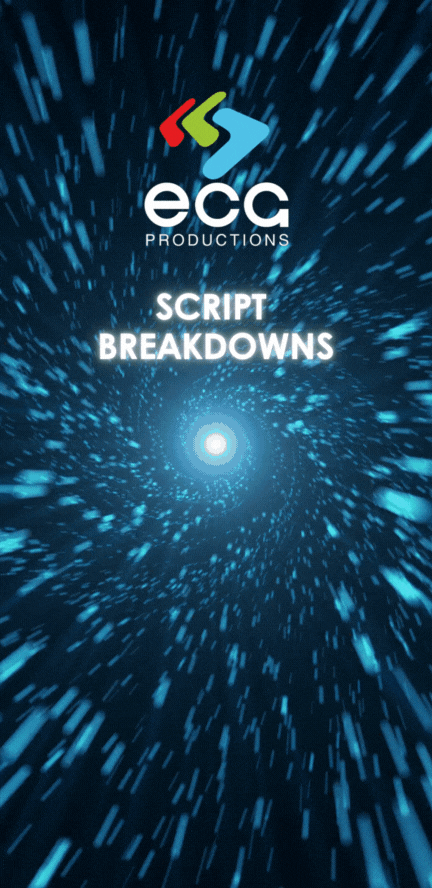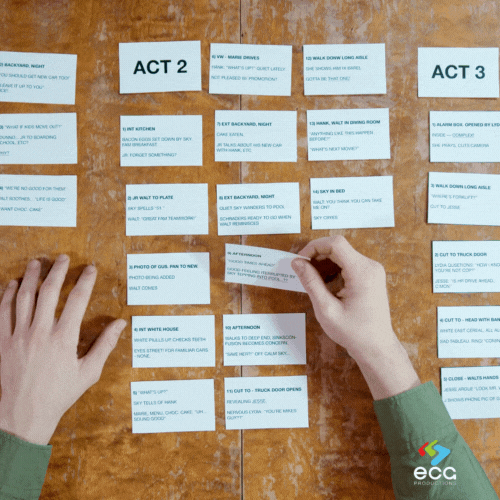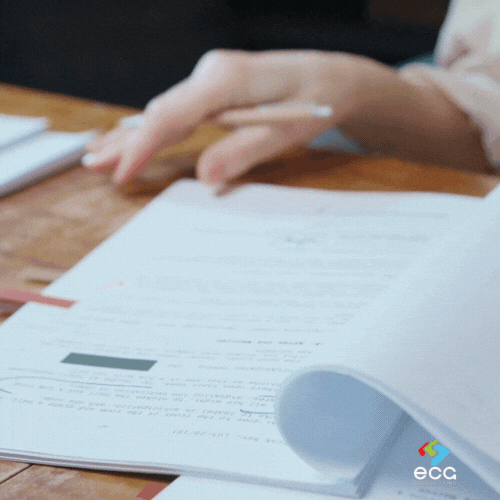- 1-855-787-4487
- info@ecgprod.com
- Mon - Fri: 10:00am - 6:30pm
A script breakdown is the bridge between a creative vision and a production-ready plan. At ECG Productions, our script breakdown services analyze every element of your script, translating it into detailed, actionable lists for every department —from props and costumes to locations and special effects. This crucial pre-production step keeps your project is organized, accurately budgeted, and ready for a smooth transition into production.
Script breakdowns lay the groundwork for production, identifying every aspect of the script that needs to be prepared, sourced, or managed. Without a comprehensive breakdown, essential details get overlooked, leading to costly delays, resource issues on set, or worst of all…reshoots! Here’s why a professional script breakdown is invaluable:
Detailed Organization: Breaking down the script provides a clear roadmap for all departments, providing a clear blueprint for all production departments.
Accurate Budgeting: A breakdown allows you to estimate costs accurately, helping you allocate resources effectively and avoid budget overages.
Enhanced Scheduling: By mapping out each scene’s needs, a breakdown is the cornerstone of an optimally scheduled production, minimizing downtime and maximizing productivity on set.


Improved Communication: A well-organized breakdown fosters clear communication between departments, meaning everyone understands the production requirements and can work together seamlessly.
Cost Efficiency: By providing a detailed inventory of all necessary resources, a breakdown prevents over-purchasing or last-minute scrambling, keeping the budget under control.
Minimized Risk: Identifying all necessary elements in advance reduces the risk of unexpected challenges on set.
Time Management: With a clear list of scene requirements, the production’s beloved Assistant Director team is best equipped to craft optimized day-of-days schedules.
At ECG Productions, we approach script breakdowns with meticulous attention to detail, ensuring that each element is identified, categorized, and prioritized. Our process includes:
Initial Script Review: We start with an in-depth read of the script, noting key elements such as characters, props, locations, wardrobe, and special effects.
Element Categorization: Every aspect of the script—props, set dressing, costumes, visual effects, stunts, and more—is categorized and listed for easy reference by each department.
Scene-by-Scene Analysis: We break down each scene individually, identifying specific needs and creating a detailed inventory to ensure all necessary resources are accounted for.
Budget Estimation: Based on the breakdown, we provide budget insights, helping to allocate resources efficiently and prepare for any special requirements.
Department-Specific Reports: We generate tailored reports for each department, ensuring that everyone has a clear understanding of their responsibilities and requirements for every scene.


Our script breakdown services are versatile and adaptable to a variety of production formats, ensuring that each project is production-ready:
Feature Films: For full-length productions, we provide a comprehensive breakdown that covers all departments, setting the stage for smooth, coordinated production days.
Television Shows: From pilots to series, we help create a consistent breakdown that keeps episodic production efficient and organized.
Commercials: For short-form content, we focus on capturing every detail, keeping schedules tight and resource management streamlined.
Documentaries & Reenactments: Our breakdowns prioritize historical accuracy and logistical requirements, keeping documentary shoots focused and effective.
Branded Content & Social Media: We prepare tailored breakdowns for branded content, ensuring all elements align with brand goals and are optimized for shorter production timelines.
At ECG Productions, we combine precision and expertise to deliver script breakdowns that cover every detail of your project. Our experienced team is committed to helping productions run smoothly, efficiently, and on budget. With a thorough, organized breakdown, your team has a clear roadmap, and you can rest assured that every element of the script will be brought to life with confidence and accuracy.
If you’re ready to turn your script into a production-ready plan, ECG Productions is here to help. Contact us today to learn more about our script breakdown services, and let’s make your production process seamless and efficient.

See how we’ve helped other clients set the stage for their successful productions. View our Work Samples.
CONTACT US
LET'S GET IN TOUCH
1-855 787-4487
Mon – Fri 9:00 AM – 6:00 PM EST
120 Interstate N Pkwy E SE #226
Atlanta, GA 30339
info@ecgprod.com
Unlock a new level of creativity and experience a truly unique and enjoyable working environment with ECG Productions. Contact us today to bring your vision to life with our award-winning video production services.
Copyright 2024 ECG Productions
Website by SuperMassive